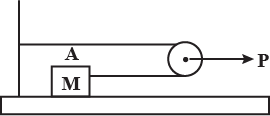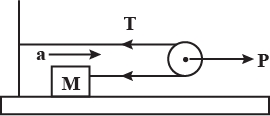
In the given figure, the pulley is massless and frictionless. There is no friction between the body and the floor. The acceleration produced in the body when it is displaced through a certain distance with force $P$ will be:

A) $\dfrac{P}{M}$
B) $\dfrac{P}{{2M}}$
C) $\dfrac{P}{{3M}}$
D) $\dfrac{P}{{4M}}$

Answer
574.8k+ views
Hint
Here, firstly in the string so tension $T$ will be applied and it will balance by the applied force $P$. And then use Newton's second law of motion.
Complete step-by-step answer:
As it is given that pulley is massless and frictionless and force $P$ is applied on it so there occurs tension in the string. As shown below

As, there are two strings the same tension $T$ is applied on the two strings. As, total tension is balanced by the force $P$ before the motion of the mass therefore,
⇒ $2T = P$
⇒ $T = \dfrac{P}{2}$………………….. (1)
Where, $T$ is tension in the strings
$P$ is the force applied on the pulley.
Now, when we apply the force $P$ then there will be the acceleration of the body through some distance then we can apply Newton's second law of motion. Which states that force applied on the body is equal to the product of mass and acceleration of the body.
⇒ $P = Ma$
Where, $M$ is the mass of the body
$a$ is the acceleration of the body
Now this force is only equal to the tension in the one string which is attached to the wall therefore,
⇒$Ma = T$
⇒ $a = \dfrac{T}{M}$………………… (2)
Now, put the value of T from equation (1) into the equation (2), we get
⇒ $a = \dfrac{P}{{2M}}$
Note:
Firstly here when the force $P$ is applied it will balance the tensions in the strings which are acting in the opposite directions to that of force $P$. Now when the force increases such that this force is greater than the total tension in the strings then the body of mass $m$ will accelerate now only the opposite force acting is the tension $T$ in the string which is attached with the wall.
Here, firstly in the string so tension $T$ will be applied and it will balance by the applied force $P$. And then use Newton's second law of motion.
Complete step-by-step answer:
As it is given that pulley is massless and frictionless and force $P$ is applied on it so there occurs tension in the string. As shown below

As, there are two strings the same tension $T$ is applied on the two strings. As, total tension is balanced by the force $P$ before the motion of the mass therefore,
⇒ $2T = P$
⇒ $T = \dfrac{P}{2}$………………….. (1)
Where, $T$ is tension in the strings
$P$ is the force applied on the pulley.
Now, when we apply the force $P$ then there will be the acceleration of the body through some distance then we can apply Newton's second law of motion. Which states that force applied on the body is equal to the product of mass and acceleration of the body.
⇒ $P = Ma$
Where, $M$ is the mass of the body
$a$ is the acceleration of the body
Now this force is only equal to the tension in the one string which is attached to the wall therefore,
⇒$Ma = T$
⇒ $a = \dfrac{T}{M}$………………… (2)
Now, put the value of T from equation (1) into the equation (2), we get
⇒ $a = \dfrac{P}{{2M}}$
Note:
Firstly here when the force $P$ is applied it will balance the tensions in the strings which are acting in the opposite directions to that of force $P$. Now when the force increases such that this force is greater than the total tension in the strings then the body of mass $m$ will accelerate now only the opposite force acting is the tension $T$ in the string which is attached with the wall.
Recently Updated Pages
Why are manures considered better than fertilizers class 11 biology CBSE

Find the coordinates of the midpoint of the line segment class 11 maths CBSE

Distinguish between static friction limiting friction class 11 physics CBSE

The Chairman of the constituent Assembly was A Jawaharlal class 11 social science CBSE

The first National Commission on Labour NCL submitted class 11 social science CBSE

Number of all subshell of n + l 7 is A 4 B 5 C 6 D class 11 chemistry CBSE

Trending doubts
What is meant by exothermic and endothermic reactions class 11 chemistry CBSE

10 examples of friction in our daily life

One Metric ton is equal to kg A 10000 B 1000 C 100 class 11 physics CBSE

1 Quintal is equal to a 110 kg b 10 kg c 100kg d 1000 class 11 physics CBSE

Difference Between Prokaryotic Cells and Eukaryotic Cells

What are Quantum numbers Explain the quantum number class 11 chemistry CBSE




